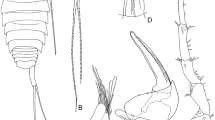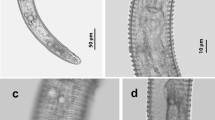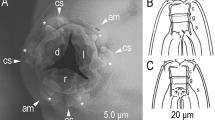Abstract
Nematodes are important: parasitic nematodes threaten the health of plants, animals and humans on a global scale1,2; interstitial nematodes pervade sediment and soil ecosystems in overwhelming numbers3; and Caenorhabditis elegans is a favourite experimental model system4. A lack of clearly homologous characters and the absence of an informative fossil record have prevented us from deriving a consistent evolutionary framework for the phylum. Here we present a phylogenetic analysis, using 53 small subunit ribosomal DNA sequences from a wide range of nematodes. With this analysis, we can compare animal-parasitic, plant-parasitic and free-living taxa using a common measurement. Our results indicate that convergent morphological evolution may be extensive and that present higher-level classification of the Nematoda will need revision. We identify five major clades within the phylum, all of which include parasitic species. We suggest that animal parasitism arose independently at least four times, and plant parasitism three times. We clarify the relationship of C. elegans to major parasitic groups; this will allow more effective exploitation of our genetic and biological knowledge of this model species.
This is a preview of subscription content, access via your institution
Access options
Subscribe to this journal
Receive 51 print issues and online access
$199.00 per year
only $3.90 per issue
Buy this article
- Purchase on Springer Link
- Instant access to full article PDF
Prices may be subject to local taxes which are calculated during checkout


Similar content being viewed by others
References
Luc, M., Sikora, R. A. & Bridge, J. Plant Parasitic Nematodes in Tropical and Subtropical Agriculture (CAB International, Wallingford, UK, (1990)).
Anderson, R. C. Nematode Parasites of Vertebrates. Their Development and Transmission (CAB International, Wallingford, UK, (1992)).
Lambshead, J. Recent developments in marine benthic biodiversity research. Oceanis 19, 5–24 (1993).
Riddle, D., Blumenthal, T., Meyer, B. & Priess, J. (eds) C. elegans II (Cold Spring Harbor Laboratory Press, NY, (1997)).
Ellis, R. E., Sulston, J. E. & Coulson, A. R. The rDNA of C. elegans: sequence and structure. Nucleic Acids Res. 14, 2345–2364 (1986).
Zarlenga, D. S., Stringfellow, F., Nobary, M. & Lichtenfels, J. R. Cloning and characterisation of ribosomal RNA genes from three species of Haemonchus (Nematoda: Trichostrongyloidea) and identification of PCR primers for rapid differentiation. Exp. Parasitol. 78, 28–36 (1994).
Fitch, D. H. A., Bugaj-gaweda, B. & Emmons, S. W. 18S ribosomal gene phylogeny for some rhabditidae related to Caenorhabditis elegans. Mol. Biol. Evol. 12, 346–358 (1995).
Baldwin, J. G., Frisse, L. M., Vida, J. T., Eddleman, C. D. & Thomas, W. K. An evolutionary framework for the study of developmental evolution in a set of nematodes related to Caenorhabditis elegans. Mol. Phylogenet. Evol. 8, 249–259 (1997).
Baldwin, J. G. et al. The buccal capsule of Aduncospiculum halicti (Nemata: Diplogasterina): an ultrastructural and molecular phylogenetic study. Can. J. Zool. 75, 407–423 (1997).
Swofford, D. L., Olsen, G. J., Waddell, P. J. & Hillis, D. M. in Molecular Systematics (eds Hillis, D. M., Moritz, C. & Mable, B. K.) 407–514 (Sinauer, Sunderland, MA, (1996))
Aguinaldo, A. M. A. et al. Evidence for a clade of nematodes, arthropods and other moulting animals. Nature 387, 489–493 (1997).
Lorenzen, S. The Phylogenetic Systematics of Free-Living Nematodes (The Ray Society, London, (1994)).
Malakhov, V. V. Nematodes. Structure, Development, Classification and Phylogeny (Smithsonian Institution Press, Washington, (1994)).
Maggenti, A. R. in Concepts in Nematode Systematics (eds Stone, A. R., Platt, H. M. & Khalil, L. F.) 25–40 (Academic, London, (1983)).
Baldwin, J. G. & Eddleman, C. D. Buccal capsule of Zeldia punctata (Nemata: Cephalobidae): an ultrastructural study. Can. J. Zool. 73, 648–656 (1995).
Etzinger, A. & Sommer, R. The homeotic gene lin-39 and the evolution of nematode epidermal cell fates. Science 278, 452–455 (1997).
Poinar, G. Origins and phylogenetic relationships of the entomophilic rhabditids, Heterorhabditis and Steinernema. Fund. Appl. Nematol. 16, 332–338 (1993).
Siddiqi, M. R. Phylogenetic relationships of the soil orders Dorylaimida, Mononchida, Triplonchida and Alaimida, with a revised classification of the subclass Enoplia. Pak. J. Nematol. 1, 79–110 (1983).
Poinar, G. O. The Natural History of Nematodes (Prentice-Hall, Englewood Cliffs, NJ, (1983)).
De Ley, P., van de Velde, M. C., Mounport, D., Baujard, P. & Coomans, A. Ultrastructure of the stoma in Cephalobidae, Panagrolaimidae and Rhabditidae, with a proposal for a revised stoma terminology in Rhabditida. Nematologica 41, 153–182 (1995).
Winnepenninckx, B. et al. 18S rRNA data indicate that Aschelminthes are polyphyletic in origin and consist of at least three distinct clades. Mol. Biol. Evol. 12, 1132–1137 (1995).
Blaxter, M. L. et al. Genes expressed in Brugia malayi infective third stage larvae. Mol. Biochem. Parasitol. 77, 77–96 (1996).
Swofford, D. L. PAUP: Phylogenetic Analysis Using Parsimony, Version 3.1 (Illinois Natural History Society, Champaign, (1993)).
Maddison, W. & Maddison, D. MacClade v3.0 (Sinauer, Sunderland, MA, (1993)).
Kumar, S., Tamura, K. & Nei, M. MEGA: Molecular Evolutionary Genetics Analysis. Version 1.0 (Pennsylvania State Univ., (1993)).
Van de Peer, Y., Rensing, S., Maire, U.-G. & De Wachter, R. Substitution rate calibration of small subunit subunit RNA identifies chlorarachniophyte nucleomorphs as remnants of green algae. Proc. Natl Acad. Sci. USA 93, 7732–7736 (1996).
Van de Peer, Y. & De Wachter, R. TREECON for Windows: a software package for the construction and drawing of evolutionary trees for the Microsoft Windows environment. Comput. Appl. Biosci. 10, 569–570 (1994).
Yang, Z. Phylogenetic Analysis by Maximum Likelihood (PAML) Version 1.2 (Univ. California, Berkeley, (1996)).
Felsenstein, J. Cases in which parsimony and compatibility methods will be positively misleading. Syst. Zool. 27, 401–410 (1978).
Acknowledgements
We thank our colleages for donations of nematode material, and D. Swofford for use of prerelease versions of PAUP*4.0. This work was supported by grants from the Wellcome Trust, the Linnean Society of London, the Belgian National Fund for Scientific Research, the NSF, the NIH and the United States Department of Agriculture.
Author information
Authors and Affiliations
Corresponding author
Rights and permissions
About this article
Cite this article
Blaxter, M., De Ley, P., Garey, J. et al. A molecular evolutionary framework for the phylum Nematoda. Nature 392, 71–75 (1998). https://doi.org/10.1038/32160
Received:
Accepted:
Issue Date:
DOI: https://doi.org/10.1038/32160
This article is cited by
-
Mitochondrial and ribosomal markers in the identification of nematodes of clinical and veterinary importance
Parasites & Vectors (2024)
-
DNA barcoding of Australian cereal cyst nematode populations with comments on likely origin and taxonomy (Tylenchoidea: Heterodera)
Phytoparasitica (2024)
-
Mechanistic insights toward identification and interaction of plant parasitic nematodes: A review
Soil Ecology Letters (2024)
-
Description, molecular identification and pathological lesions of Huffmanela persica sp. nov. (Nematoda: Trichosomoididae: Huffmanelinae) from the daggertooth pike conger Muraenesox cinereus
Parasites & Vectors (2023)
-
The complete mitochondrial genome of Wellcomia compar (Spirurina: Oxyuridae) and its genome characterization and phylogenetic analysis
Scientific Reports (2023)
Comments
By submitting a comment you agree to abide by our Terms and Community Guidelines. If you find something abusive or that does not comply with our terms or guidelines please flag it as inappropriate.



